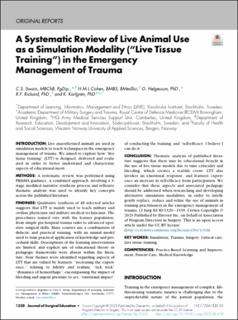| dc.contributor.author | Swain, Cara S. | |
| dc.contributor.author | Cohen, H.M.L. | |
| dc.contributor.author | Helgesson, Gert | |
| dc.contributor.author | Rickard, Rory | |
| dc.contributor.author | Karlgren, Klas | |
| dc.date.accessioned | 2023-12-27T06:37:13Z | |
| dc.date.available | 2023-12-27T06:37:13Z | |
| dc.date.created | 2023-09-19T11:25:39Z | |
| dc.date.issued | 2023 | |
| dc.identifier.citation | Journal of Surgical Education. 2023, 80 (9), 1320-1339. | en_US |
| dc.identifier.issn | 1931-7204 | |
| dc.identifier.uri | https://hdl.handle.net/11250/3108898 | |
| dc.description.abstract | Introduction:
Live anaesthetized animals are used as simulation models to teach techniques in the emergency management of trauma. We aimed to explore how “live tissue training” (LTT) is designed, delivered and evaluated in order to better understand and characterize aspects of educational merit.
Methods:
A systematic review was performed using PRISMA guidance. A combined approach, involving a 3-stage modified narrative synthesis process and reflexive thematic analysis was used to identify key concepts across the published literature.
Findings:
Qualitative synthesis of 48 selected articles suggests that LTT is mainly used to teach military and civilian physicians and military medical technicians. The procedures trained vary with the learner population, from simple pre-hospital trauma tasks to advanced operative surgical skills. Many courses use a combination of didactic and practical training, with an animal model used to train practical application of knowledge and procedural skills. Descriptions of the learning interventions are limited, and explicit use of educational theory or pedagogic frameworks were absent within the literature. Four themes were identified regarding aspects of LTT that are valued by learners: “recreating the experience,” relating to fidelity and realism; “tick tock” “dynamics of hemorrhage”, encompassing the impact of bleeding and urgent pressure to act; “emotional impact” of conducting the training, and “self-efficacy: I believe I can do it.”
Conclusion:
Thematic analysis of published literature suggests that there may be educational benefit in the use of live tissue models due to time criticality and bleeding, which creates a real-life event. LTT also invokes an emotional response, and learners experience an increase in self-efficacy from participation. We consider that these aspects and associated pedagogy should be addressed when researching and developing alternative simulation modalities, in order to intelligently replace, reduce and refine the use of animals in training practitioners in the emergency management of trauma. | en_US |
| dc.language.iso | eng | en_US |
| dc.publisher | Elsevier | en_US |
| dc.rights | Navngivelse 4.0 Internasjonal | * |
| dc.rights.uri | http://creativecommons.org/licenses/by/4.0/deed.no | * |
| dc.title | A Systematic Review of Live Animal Use as a Simulation Modality (“Live Tissue Training”) in the Emergency Management of Trauma | en_US |
| dc.type | Peer reviewed | en_US |
| dc.type | Journal article | en_US |
| dc.description.version | publishedVersion | en_US |
| dc.source.pagenumber | 1320-1339 | en_US |
| dc.source.volume | 80 | en_US |
| dc.source.journal | Journal of Surgical Education | en_US |
| dc.source.issue | 9 | en_US |
| dc.identifier.doi | 10.1016/j.jsurg.2023.06.018 | |
| dc.identifier.cristin | 2176427 | |
| cristin.ispublished | true | |
| cristin.fulltext | original | |
| cristin.qualitycode | 1 | |

